Analyzing the Marijuana Gateway Theory: Addiction and Brain Impact
VerifiedAdded on 2021/09/13
|8
|1833
|60
Essay
AI Summary
This essay delves into the marijuana gateway theory, presenting arguments for and against the proposition that marijuana use leads to the use of more addictive and dangerous drugs. It discusses the potential impact of marijuana on brain activity, particularly in adolescents, and how it might increase vulnerability to addiction. The essay also explores the correlation between marijuana use and the subsequent use of other illicit drugs like heroin, referencing studies and research on the topic. It acknowledges that while some individuals may use marijuana recreationally or medically without progressing to harder drugs, a significant percentage do, highlighting the need for caution and responsible drug policies. The essay concludes by emphasizing the importance of controlling marijuana use to prevent the potential escalation to more harmful drug dependencies, while acknowledging the need for medical use under prescription.
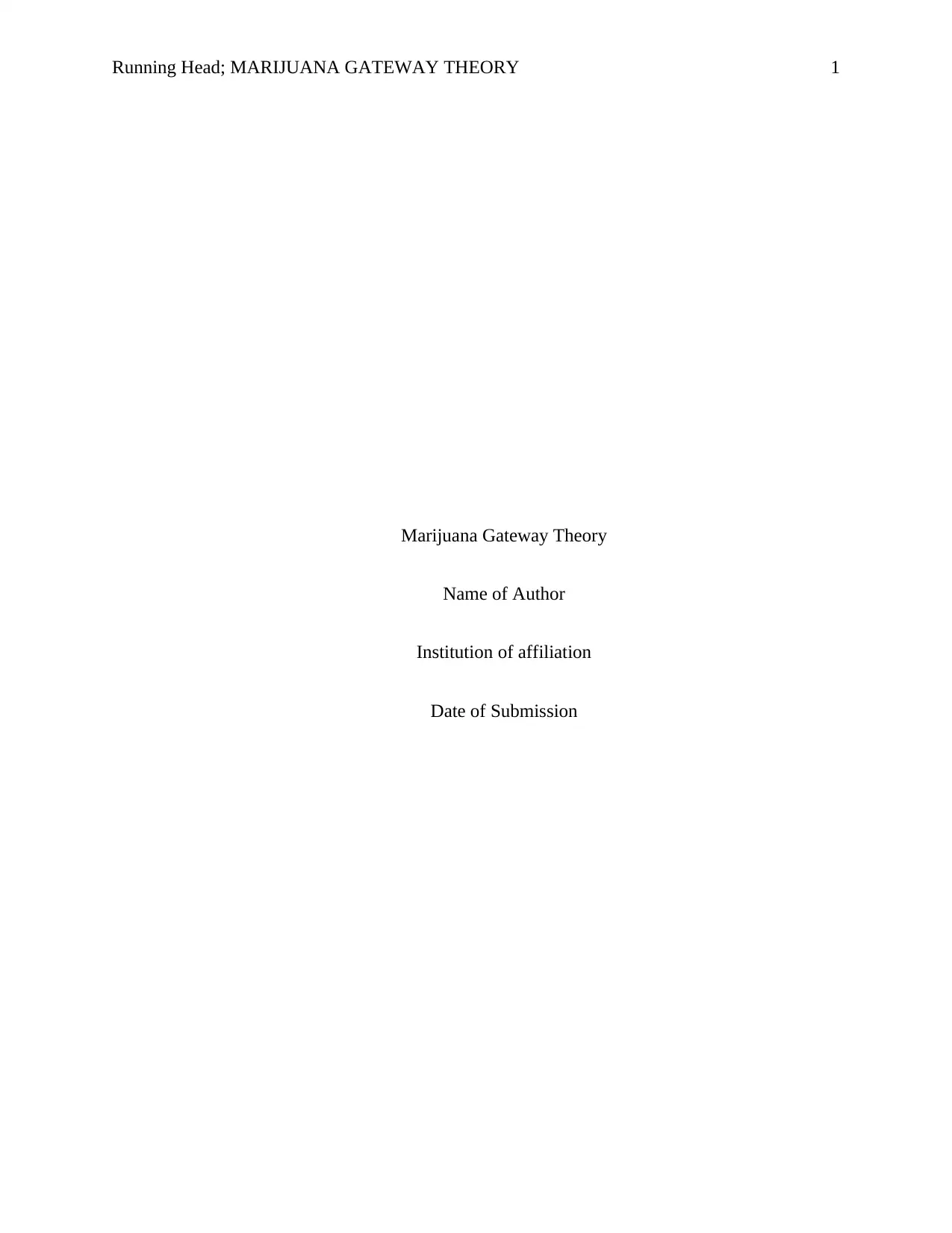
Running Head; MARIJUANA GATEWAY THEORY 1
Marijuana Gateway Theory
Name of Author
Institution of affiliation
Date of Submission
Marijuana Gateway Theory
Name of Author
Institution of affiliation
Date of Submission
Paraphrase This Document
Need a fresh take? Get an instant paraphrase of this document with our AI Paraphraser
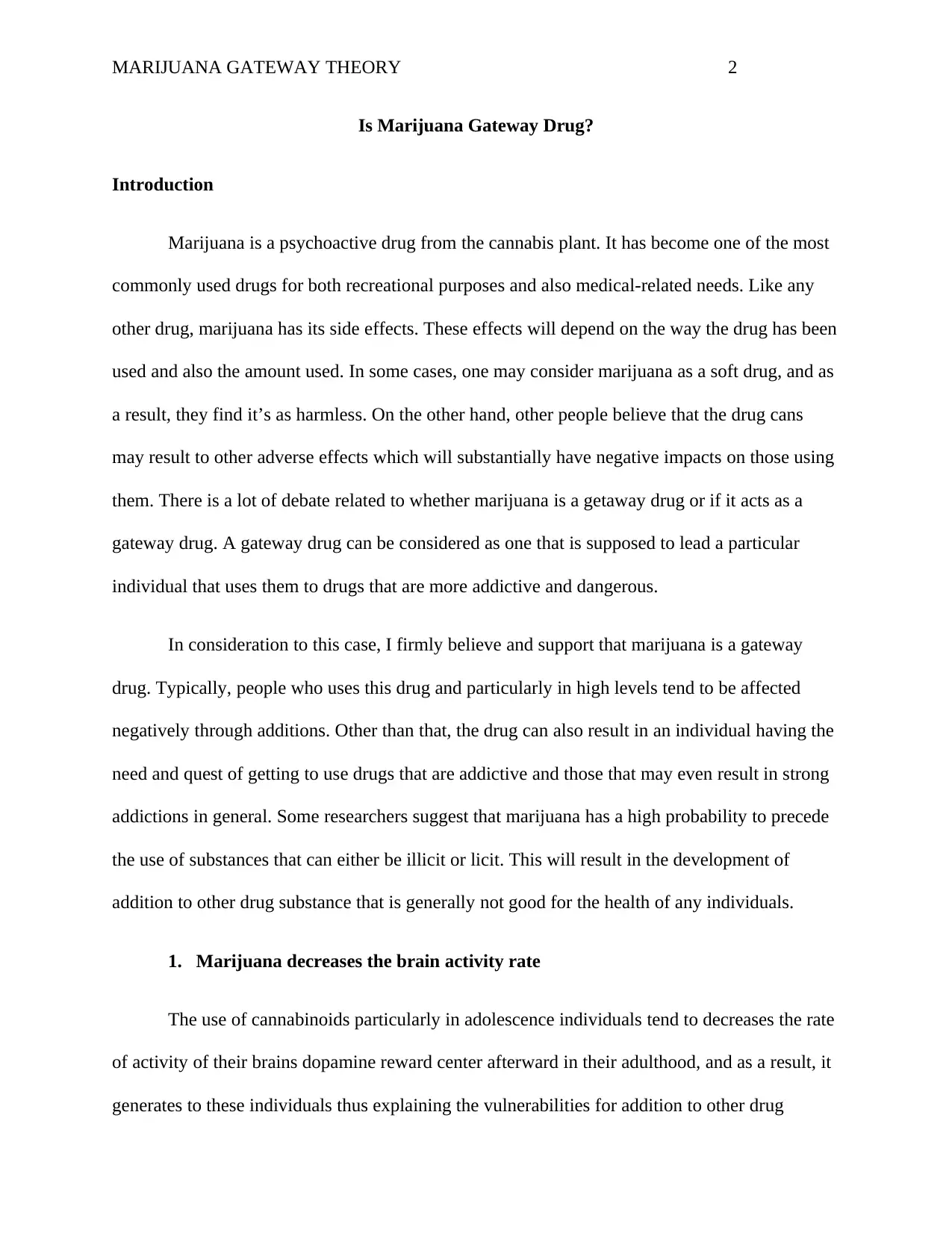
MARIJUANA GATEWAY THEORY 2
Is Marijuana Gateway Drug?
Introduction
Marijuana is a psychoactive drug from the cannabis plant. It has become one of the most
commonly used drugs for both recreational purposes and also medical-related needs. Like any
other drug, marijuana has its side effects. These effects will depend on the way the drug has been
used and also the amount used. In some cases, one may consider marijuana as a soft drug, and as
a result, they find it’s as harmless. On the other hand, other people believe that the drug cans
may result to other adverse effects which will substantially have negative impacts on those using
them. There is a lot of debate related to whether marijuana is a getaway drug or if it acts as a
gateway drug. A gateway drug can be considered as one that is supposed to lead a particular
individual that uses them to drugs that are more addictive and dangerous.
In consideration to this case, I firmly believe and support that marijuana is a gateway
drug. Typically, people who uses this drug and particularly in high levels tend to be affected
negatively through additions. Other than that, the drug can also result in an individual having the
need and quest of getting to use drugs that are addictive and those that may even result in strong
addictions in general. Some researchers suggest that marijuana has a high probability to precede
the use of substances that can either be illicit or licit. This will result in the development of
addition to other drug substance that is generally not good for the health of any individuals.
1. Marijuana decreases the brain activity rate
The use of cannabinoids particularly in adolescence individuals tend to decreases the rate
of activity of their brains dopamine reward center afterward in their adulthood, and as a result, it
generates to these individuals thus explaining the vulnerabilities for addition to other drug
Is Marijuana Gateway Drug?
Introduction
Marijuana is a psychoactive drug from the cannabis plant. It has become one of the most
commonly used drugs for both recreational purposes and also medical-related needs. Like any
other drug, marijuana has its side effects. These effects will depend on the way the drug has been
used and also the amount used. In some cases, one may consider marijuana as a soft drug, and as
a result, they find it’s as harmless. On the other hand, other people believe that the drug cans
may result to other adverse effects which will substantially have negative impacts on those using
them. There is a lot of debate related to whether marijuana is a getaway drug or if it acts as a
gateway drug. A gateway drug can be considered as one that is supposed to lead a particular
individual that uses them to drugs that are more addictive and dangerous.
In consideration to this case, I firmly believe and support that marijuana is a gateway
drug. Typically, people who uses this drug and particularly in high levels tend to be affected
negatively through additions. Other than that, the drug can also result in an individual having the
need and quest of getting to use drugs that are addictive and those that may even result in strong
addictions in general. Some researchers suggest that marijuana has a high probability to precede
the use of substances that can either be illicit or licit. This will result in the development of
addition to other drug substance that is generally not good for the health of any individuals.
1. Marijuana decreases the brain activity rate
The use of cannabinoids particularly in adolescence individuals tend to decreases the rate
of activity of their brains dopamine reward center afterward in their adulthood, and as a result, it
generates to these individuals thus explaining the vulnerabilities for addition to other drug
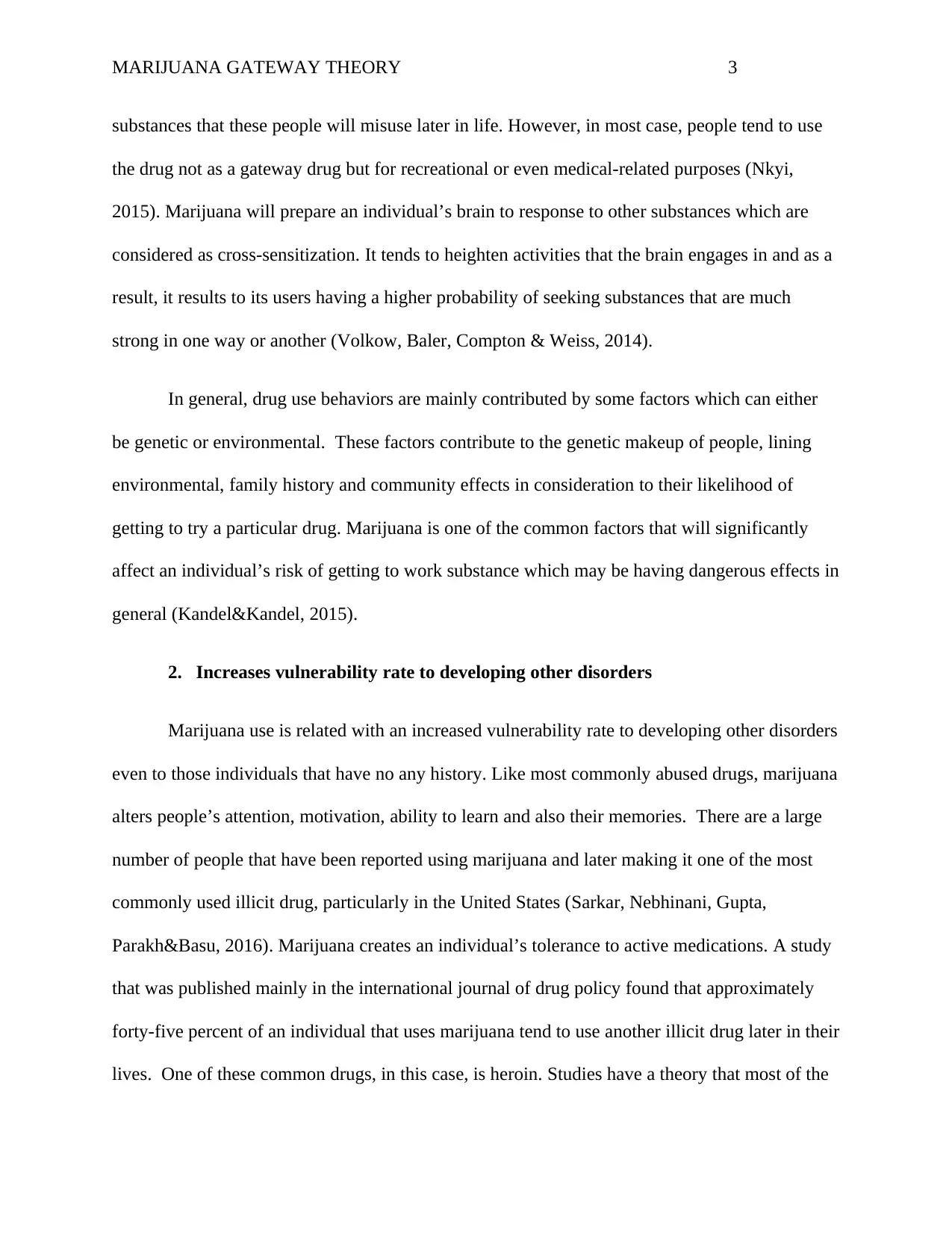
MARIJUANA GATEWAY THEORY 3
substances that these people will misuse later in life. However, in most case, people tend to use
the drug not as a gateway drug but for recreational or even medical-related purposes (Nkyi,
2015). Marijuana will prepare an individual’s brain to response to other substances which are
considered as cross-sensitization. It tends to heighten activities that the brain engages in and as a
result, it results to its users having a higher probability of seeking substances that are much
strong in one way or another (Volkow, Baler, Compton & Weiss, 2014).
In general, drug use behaviors are mainly contributed by some factors which can either
be genetic or environmental. These factors contribute to the genetic makeup of people, lining
environmental, family history and community effects in consideration to their likelihood of
getting to try a particular drug. Marijuana is one of the common factors that will significantly
affect an individual’s risk of getting to work substance which may be having dangerous effects in
general (Kandel&Kandel, 2015).
2. Increases vulnerability rate to developing other disorders
Marijuana use is related with an increased vulnerability rate to developing other disorders
even to those individuals that have no any history. Like most commonly abused drugs, marijuana
alters people’s attention, motivation, ability to learn and also their memories. There are a large
number of people that have been reported using marijuana and later making it one of the most
commonly used illicit drug, particularly in the United States (Sarkar, Nebhinani, Gupta,
Parakh&Basu, 2016). Marijuana creates an individual’s tolerance to active medications. A study
that was published mainly in the international journal of drug policy found that approximately
forty-five percent of an individual that uses marijuana tend to use another illicit drug later in their
lives. One of these common drugs, in this case, is heroin. Studies have a theory that most of the
substances that these people will misuse later in life. However, in most case, people tend to use
the drug not as a gateway drug but for recreational or even medical-related purposes (Nkyi,
2015). Marijuana will prepare an individual’s brain to response to other substances which are
considered as cross-sensitization. It tends to heighten activities that the brain engages in and as a
result, it results to its users having a higher probability of seeking substances that are much
strong in one way or another (Volkow, Baler, Compton & Weiss, 2014).
In general, drug use behaviors are mainly contributed by some factors which can either
be genetic or environmental. These factors contribute to the genetic makeup of people, lining
environmental, family history and community effects in consideration to their likelihood of
getting to try a particular drug. Marijuana is one of the common factors that will significantly
affect an individual’s risk of getting to work substance which may be having dangerous effects in
general (Kandel&Kandel, 2015).
2. Increases vulnerability rate to developing other disorders
Marijuana use is related with an increased vulnerability rate to developing other disorders
even to those individuals that have no any history. Like most commonly abused drugs, marijuana
alters people’s attention, motivation, ability to learn and also their memories. There are a large
number of people that have been reported using marijuana and later making it one of the most
commonly used illicit drug, particularly in the United States (Sarkar, Nebhinani, Gupta,
Parakh&Basu, 2016). Marijuana creates an individual’s tolerance to active medications. A study
that was published mainly in the international journal of drug policy found that approximately
forty-five percent of an individual that uses marijuana tend to use another illicit drug later in their
lives. One of these common drugs, in this case, is heroin. Studies have a theory that most of the
⊘ This is a preview!⊘
Do you want full access?
Subscribe today to unlock all pages.

Trusted by 1+ million students worldwide
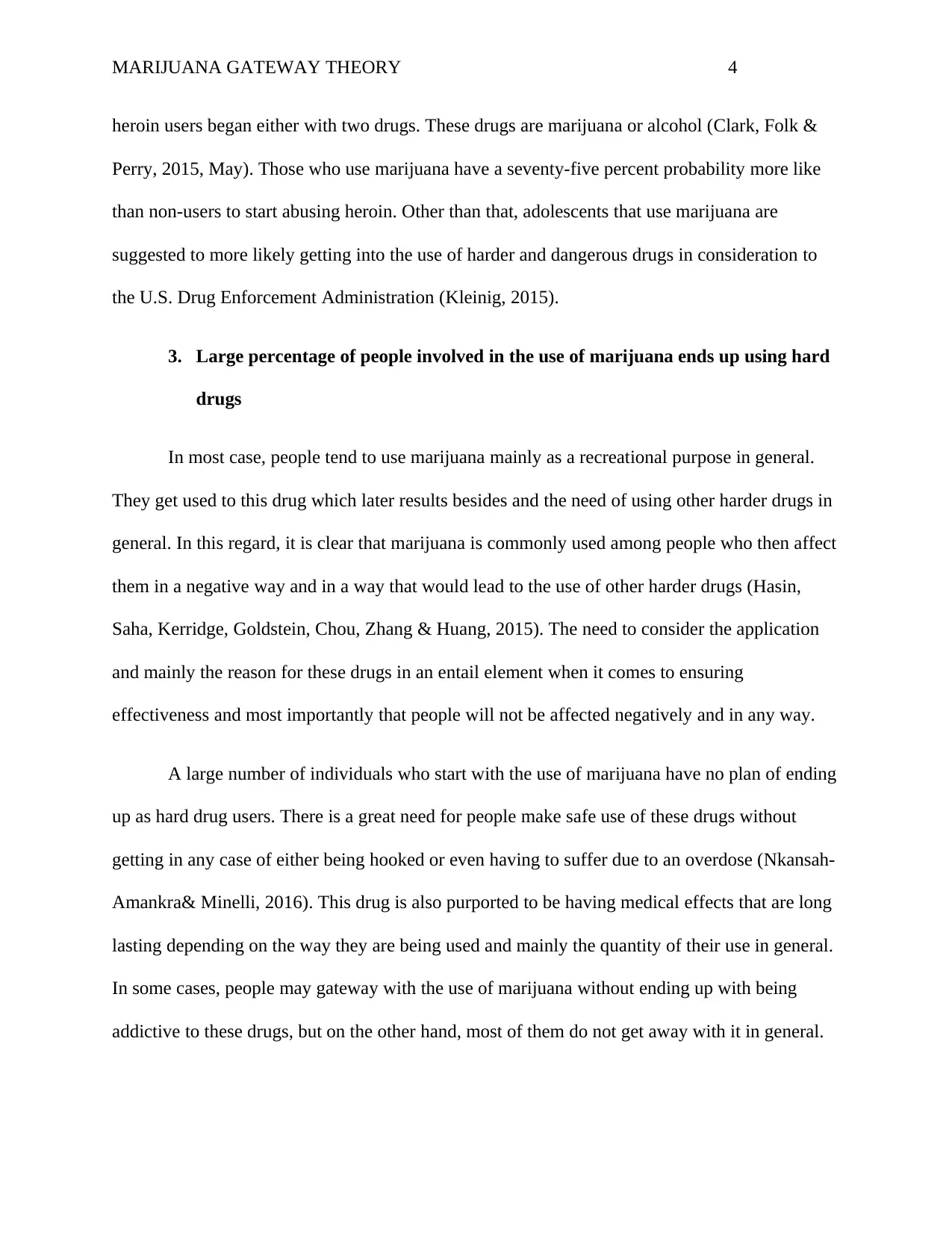
MARIJUANA GATEWAY THEORY 4
heroin users began either with two drugs. These drugs are marijuana or alcohol (Clark, Folk &
Perry, 2015, May). Those who use marijuana have a seventy-five percent probability more like
than non-users to start abusing heroin. Other than that, adolescents that use marijuana are
suggested to more likely getting into the use of harder and dangerous drugs in consideration to
the U.S. Drug Enforcement Administration (Kleinig, 2015).
3. Large percentage of people involved in the use of marijuana ends up using hard
drugs
In most case, people tend to use marijuana mainly as a recreational purpose in general.
They get used to this drug which later results besides and the need of using other harder drugs in
general. In this regard, it is clear that marijuana is commonly used among people who then affect
them in a negative way and in a way that would lead to the use of other harder drugs (Hasin,
Saha, Kerridge, Goldstein, Chou, Zhang & Huang, 2015). The need to consider the application
and mainly the reason for these drugs in an entail element when it comes to ensuring
effectiveness and most importantly that people will not be affected negatively and in any way.
A large number of individuals who start with the use of marijuana have no plan of ending
up as hard drug users. There is a great need for people make safe use of these drugs without
getting in any case of either being hooked or even having to suffer due to an overdose (Nkansah-
Amankra& Minelli, 2016). This drug is also purported to be having medical effects that are long
lasting depending on the way they are being used and mainly the quantity of their use in general.
In some cases, people may gateway with the use of marijuana without ending up with being
addictive to these drugs, but on the other hand, most of them do not get away with it in general.
heroin users began either with two drugs. These drugs are marijuana or alcohol (Clark, Folk &
Perry, 2015, May). Those who use marijuana have a seventy-five percent probability more like
than non-users to start abusing heroin. Other than that, adolescents that use marijuana are
suggested to more likely getting into the use of harder and dangerous drugs in consideration to
the U.S. Drug Enforcement Administration (Kleinig, 2015).
3. Large percentage of people involved in the use of marijuana ends up using hard
drugs
In most case, people tend to use marijuana mainly as a recreational purpose in general.
They get used to this drug which later results besides and the need of using other harder drugs in
general. In this regard, it is clear that marijuana is commonly used among people who then affect
them in a negative way and in a way that would lead to the use of other harder drugs (Hasin,
Saha, Kerridge, Goldstein, Chou, Zhang & Huang, 2015). The need to consider the application
and mainly the reason for these drugs in an entail element when it comes to ensuring
effectiveness and most importantly that people will not be affected negatively and in any way.
A large number of individuals who start with the use of marijuana have no plan of ending
up as hard drug users. There is a great need for people make safe use of these drugs without
getting in any case of either being hooked or even having to suffer due to an overdose (Nkansah-
Amankra& Minelli, 2016). This drug is also purported to be having medical effects that are long
lasting depending on the way they are being used and mainly the quantity of their use in general.
In some cases, people may gateway with the use of marijuana without ending up with being
addictive to these drugs, but on the other hand, most of them do not get away with it in general.
Paraphrase This Document
Need a fresh take? Get an instant paraphrase of this document with our AI Paraphraser
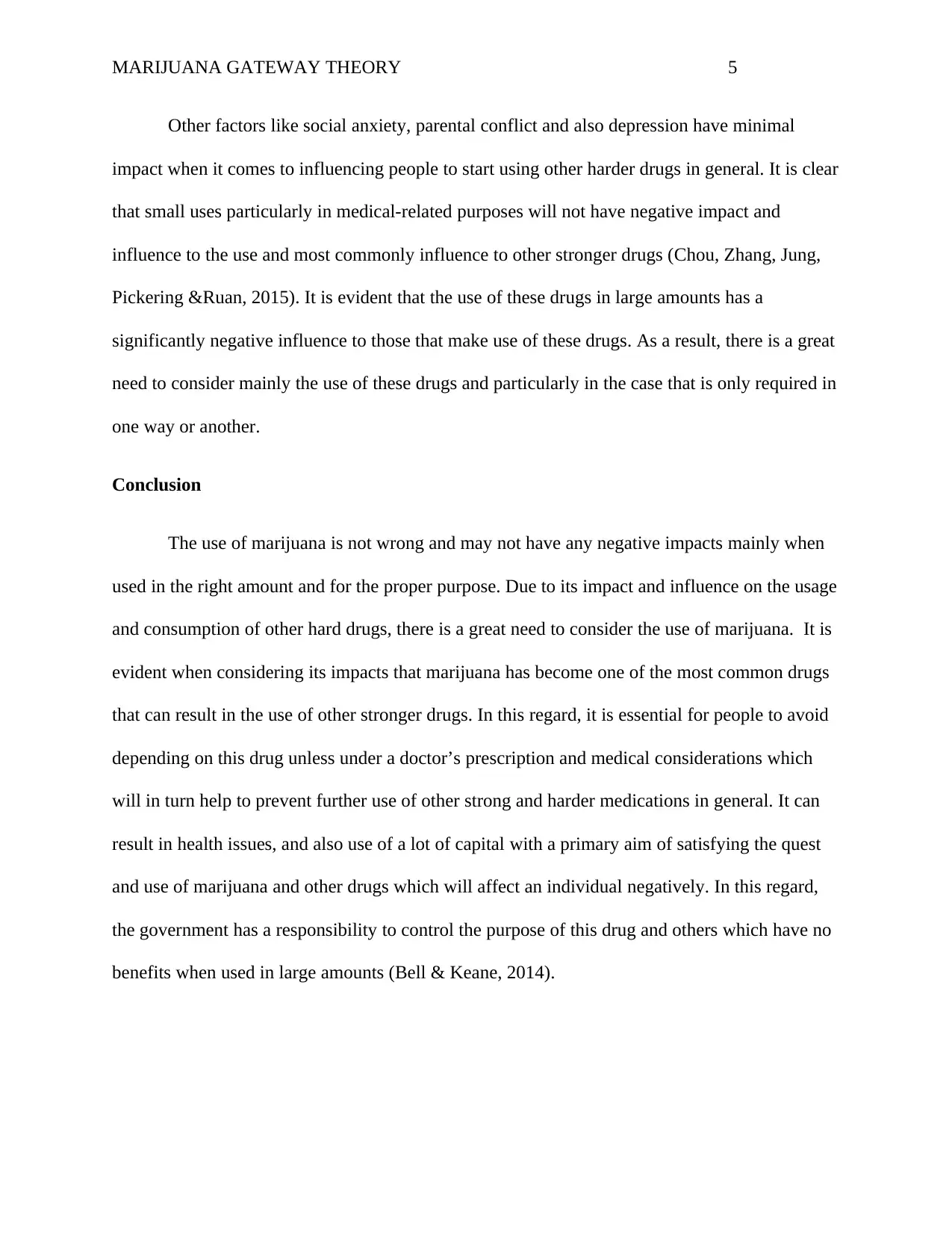
MARIJUANA GATEWAY THEORY 5
Other factors like social anxiety, parental conflict and also depression have minimal
impact when it comes to influencing people to start using other harder drugs in general. It is clear
that small uses particularly in medical-related purposes will not have negative impact and
influence to the use and most commonly influence to other stronger drugs (Chou, Zhang, Jung,
Pickering &Ruan, 2015). It is evident that the use of these drugs in large amounts has a
significantly negative influence to those that make use of these drugs. As a result, there is a great
need to consider mainly the use of these drugs and particularly in the case that is only required in
one way or another.
Conclusion
The use of marijuana is not wrong and may not have any negative impacts mainly when
used in the right amount and for the proper purpose. Due to its impact and influence on the usage
and consumption of other hard drugs, there is a great need to consider the use of marijuana. It is
evident when considering its impacts that marijuana has become one of the most common drugs
that can result in the use of other stronger drugs. In this regard, it is essential for people to avoid
depending on this drug unless under a doctor’s prescription and medical considerations which
will in turn help to prevent further use of other strong and harder medications in general. It can
result in health issues, and also use of a lot of capital with a primary aim of satisfying the quest
and use of marijuana and other drugs which will affect an individual negatively. In this regard,
the government has a responsibility to control the purpose of this drug and others which have no
benefits when used in large amounts (Bell & Keane, 2014).
Other factors like social anxiety, parental conflict and also depression have minimal
impact when it comes to influencing people to start using other harder drugs in general. It is clear
that small uses particularly in medical-related purposes will not have negative impact and
influence to the use and most commonly influence to other stronger drugs (Chou, Zhang, Jung,
Pickering &Ruan, 2015). It is evident that the use of these drugs in large amounts has a
significantly negative influence to those that make use of these drugs. As a result, there is a great
need to consider mainly the use of these drugs and particularly in the case that is only required in
one way or another.
Conclusion
The use of marijuana is not wrong and may not have any negative impacts mainly when
used in the right amount and for the proper purpose. Due to its impact and influence on the usage
and consumption of other hard drugs, there is a great need to consider the use of marijuana. It is
evident when considering its impacts that marijuana has become one of the most common drugs
that can result in the use of other stronger drugs. In this regard, it is essential for people to avoid
depending on this drug unless under a doctor’s prescription and medical considerations which
will in turn help to prevent further use of other strong and harder medications in general. It can
result in health issues, and also use of a lot of capital with a primary aim of satisfying the quest
and use of marijuana and other drugs which will affect an individual negatively. In this regard,
the government has a responsibility to control the purpose of this drug and others which have no
benefits when used in large amounts (Bell & Keane, 2014).

MARIJUANA GATEWAY THEORY 6
References
References
⊘ This is a preview!⊘
Do you want full access?
Subscribe today to unlock all pages.

Trusted by 1+ million students worldwide
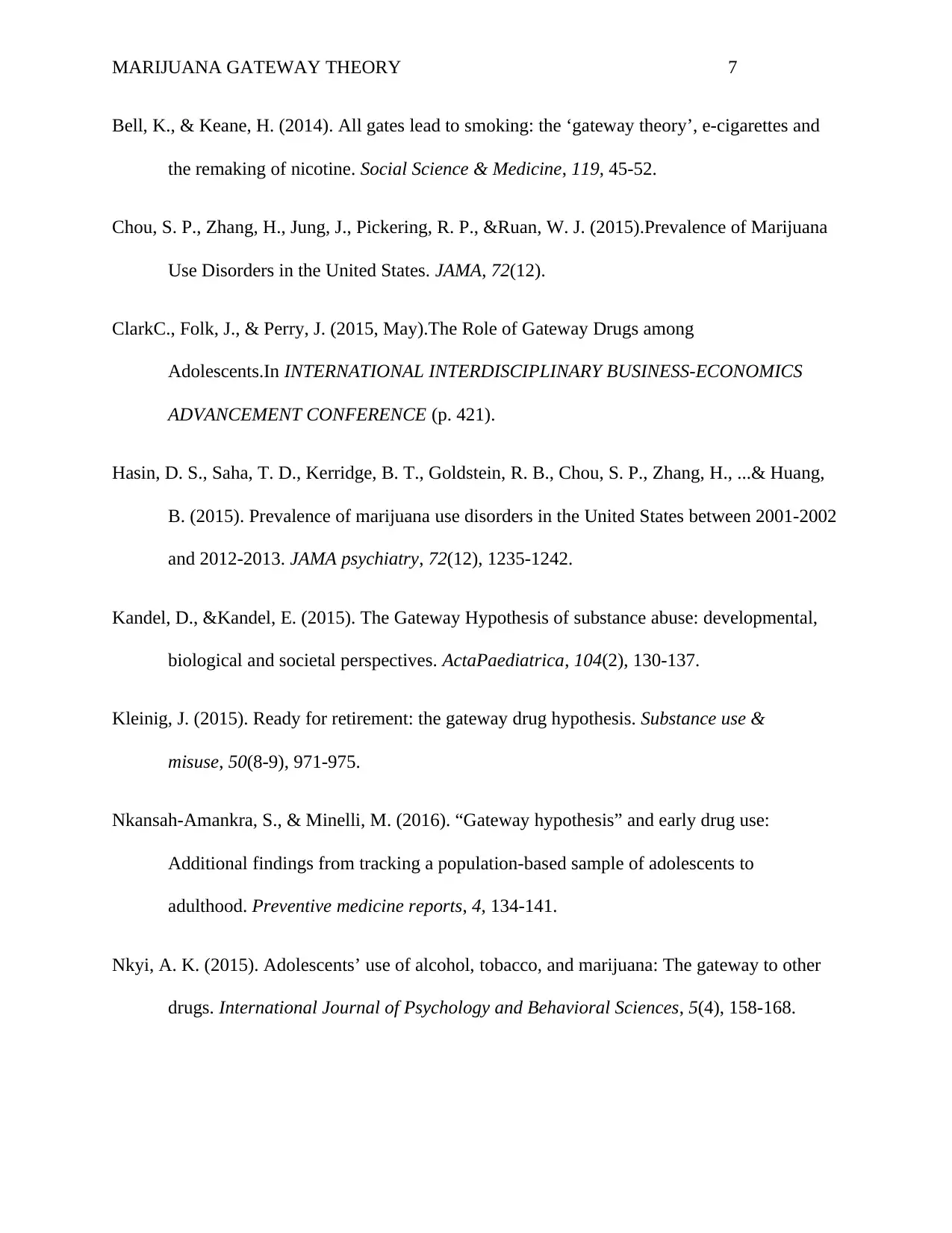
MARIJUANA GATEWAY THEORY 7
Bell, K., & Keane, H. (2014). All gates lead to smoking: the ‘gateway theory’, e-cigarettes and
the remaking of nicotine. Social Science & Medicine, 119, 45-52.
Chou, S. P., Zhang, H., Jung, J., Pickering, R. P., &Ruan, W. J. (2015).Prevalence of Marijuana
Use Disorders in the United States. JAMA, 72(12).
ClarkC., Folk, J., & Perry, J. (2015, May).The Role of Gateway Drugs among
Adolescents.In INTERNATIONAL INTERDISCIPLINARY BUSINESS-ECONOMICS
ADVANCEMENT CONFERENCE (p. 421).
Hasin, D. S., Saha, T. D., Kerridge, B. T., Goldstein, R. B., Chou, S. P., Zhang, H., ...& Huang,
B. (2015). Prevalence of marijuana use disorders in the United States between 2001-2002
and 2012-2013. JAMA psychiatry, 72(12), 1235-1242.
Kandel, D., &Kandel, E. (2015). The Gateway Hypothesis of substance abuse: developmental,
biological and societal perspectives. ActaPaediatrica, 104(2), 130-137.
Kleinig, J. (2015). Ready for retirement: the gateway drug hypothesis. Substance use &
misuse, 50(8-9), 971-975.
Nkansah-Amankra, S., & Minelli, M. (2016). “Gateway hypothesis” and early drug use:
Additional findings from tracking a population-based sample of adolescents to
adulthood. Preventive medicine reports, 4, 134-141.
Nkyi, A. K. (2015). Adolescents’ use of alcohol, tobacco, and marijuana: The gateway to other
drugs. International Journal of Psychology and Behavioral Sciences, 5(4), 158-168.
Bell, K., & Keane, H. (2014). All gates lead to smoking: the ‘gateway theory’, e-cigarettes and
the remaking of nicotine. Social Science & Medicine, 119, 45-52.
Chou, S. P., Zhang, H., Jung, J., Pickering, R. P., &Ruan, W. J. (2015).Prevalence of Marijuana
Use Disorders in the United States. JAMA, 72(12).
ClarkC., Folk, J., & Perry, J. (2015, May).The Role of Gateway Drugs among
Adolescents.In INTERNATIONAL INTERDISCIPLINARY BUSINESS-ECONOMICS
ADVANCEMENT CONFERENCE (p. 421).
Hasin, D. S., Saha, T. D., Kerridge, B. T., Goldstein, R. B., Chou, S. P., Zhang, H., ...& Huang,
B. (2015). Prevalence of marijuana use disorders in the United States between 2001-2002
and 2012-2013. JAMA psychiatry, 72(12), 1235-1242.
Kandel, D., &Kandel, E. (2015). The Gateway Hypothesis of substance abuse: developmental,
biological and societal perspectives. ActaPaediatrica, 104(2), 130-137.
Kleinig, J. (2015). Ready for retirement: the gateway drug hypothesis. Substance use &
misuse, 50(8-9), 971-975.
Nkansah-Amankra, S., & Minelli, M. (2016). “Gateway hypothesis” and early drug use:
Additional findings from tracking a population-based sample of adolescents to
adulthood. Preventive medicine reports, 4, 134-141.
Nkyi, A. K. (2015). Adolescents’ use of alcohol, tobacco, and marijuana: The gateway to other
drugs. International Journal of Psychology and Behavioral Sciences, 5(4), 158-168.
Paraphrase This Document
Need a fresh take? Get an instant paraphrase of this document with our AI Paraphraser
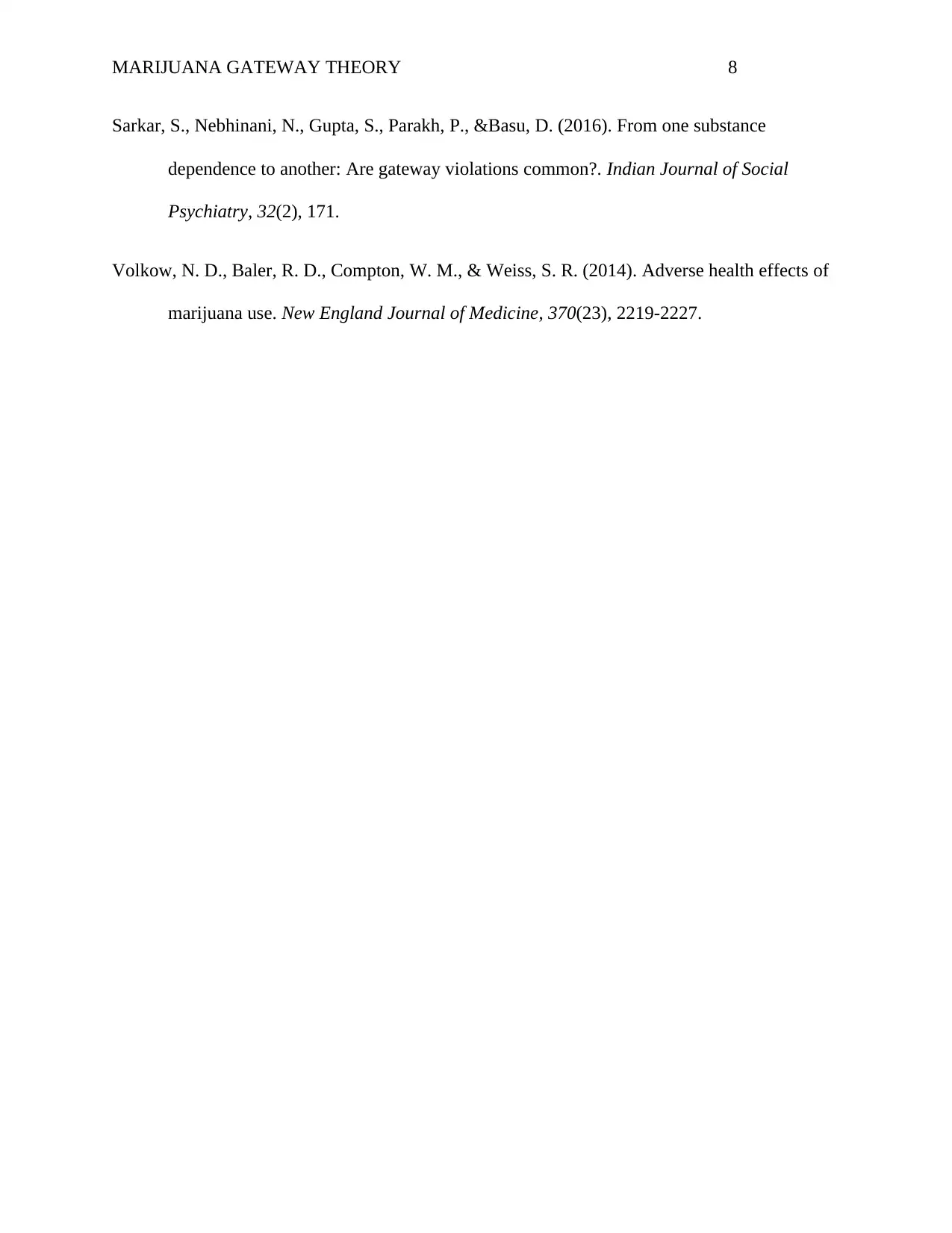
MARIJUANA GATEWAY THEORY 8
Sarkar, S., Nebhinani, N., Gupta, S., Parakh, P., &Basu, D. (2016). From one substance
dependence to another: Are gateway violations common?. Indian Journal of Social
Psychiatry, 32(2), 171.
Volkow, N. D., Baler, R. D., Compton, W. M., & Weiss, S. R. (2014). Adverse health effects of
marijuana use. New England Journal of Medicine, 370(23), 2219-2227.
Sarkar, S., Nebhinani, N., Gupta, S., Parakh, P., &Basu, D. (2016). From one substance
dependence to another: Are gateway violations common?. Indian Journal of Social
Psychiatry, 32(2), 171.
Volkow, N. D., Baler, R. D., Compton, W. M., & Weiss, S. R. (2014). Adverse health effects of
marijuana use. New England Journal of Medicine, 370(23), 2219-2227.
1 out of 8
Related Documents
Your All-in-One AI-Powered Toolkit for Academic Success.
+13062052269
info@desklib.com
Available 24*7 on WhatsApp / Email
![[object Object]](/_next/static/media/star-bottom.7253800d.svg)
Unlock your academic potential
Copyright © 2020–2025 A2Z Services. All Rights Reserved. Developed and managed by ZUCOL.





